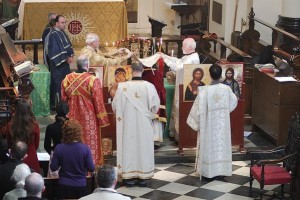By Peter Oborne, The Telegraph

It’s Sunday morning on Upper Street in the heart of London’s secular, left-wing Islington. The shops and cafés are doing a lively business and the pubs have opened.
But outside the portico of a handsome Georgian church stands an anachronistic figure. His white surplice flapping in the wind, vicar Simon Harvey is intent on luring shoppers into his Sunday service.
He is surprisingly successful. With a smile and a welcoming word for everyone, by 11am Harvey has gathered more than 100 worshippers inside St Mary’s Upper Street.
It is a mixed congregation: a mixture of young and old, black and white, the respectable middle class and the very poor. City bankers mingle with asylum seekers.
There’s a choir in the church, and plenty of children, who are taken downstairs to their Sunday School classes shortly after the service begins. The hymns are rousing and cheerful. Many of the congregation even appear to believe in God, not something that can by any means always be taken for granted in the Church of England.
What’s more, slowly but surely, the St Mary’s congregation seems to be swelling. Over the last 12 months, attendance at the main Sunday service at the church (where my wife Martine is curate) has risen by nearly 20 per cent, from around 95 to 115. Though much of this is down to Harvey’s hard work and charisma, the growing popularity of St Mary’s is part of a much wider and very striking phenomenon.
Church attendances, in freefall for so long, have started to rise again, particularly in Britain’s capital city. Numbers on the electoral rolls are increasing by well over two per cent every year, while some churches have seen truly dramatic rises in numbers.
Change is afoot. For many years it was accepted that Christianity was all but dead, an anachronistic relic of the past whose foundations had been destroyed by modern science and rationalism, before being left behind by the cultural and sexual revolution of the Sixties. The figures seem to bear this out. Church attendance — which stood at around 50 per cent in the middle of the 19th century – had declined to around 12 per cent in 1979, or 5.4 million. By 1998 it had almost halved to 7.5 per cent and when the most recent census was conducted in 2005, it was discovered that only 6.3 per cent of the population, some 3.2 million, were regular churchgoers. The number of people calling themselves members of the Church of England has collapsed to 20 per cent, according to the latest British Social Attitudes Survey, down from 40 per cent as recently as 1983. More than half of all Britons, according to British Social Attitudes, say they have “no religion” and never attend a religious service.
Despondent churchmen judged that there were just too many alternative attractions — Sunday shopping, sports fixtures and the relentless secularism of modern Britain. Only Islam, fuelled by immigration and more disciplined and certain faith, appeared to be growing.
But, as St Mary’s Upper Street shows, there is still that yearning for faith. Indeed, as the second decade of the 21st century gets under way, there is surely a change of public mood. There have been many wonderful things about the last half-century, but it is impossible to deny that it has been an era of materialism and selfishness. The religious impulse has not quite vanished, but the teachings of the church have been mocked and suppressed. It may be that in an age of austerity, we are collectively coming back to the profound and ancient verities of the gospels.
I asked Simon Harvey the secret of his success. A cheerful priest in his mid-forties, he makes no grand pronouncements – just stresses the importance of being friendly: “This church is massive and it can appear a bit terrifying to local people. For many people, the threshold is the hardest place to cross. We need to get them through the door.” And once inside, Harvey concentrates on making people feel wanted: “Sometimes within hours of coming through the door, they are sitting down for lunch in the vicarage.”
Harvey, who was a minister in Leicester for many years before moving to London, also stresses the importance of being a full-time vicar: “In London, every parish has a church and a minister, whereas in other parts of the country, clergy can cover 8-12 churches. You’ve got to have a relationship with the minister, you’ve got to have somebody out there in the front of the church.”
St Mary’s is doing something rather special. Islington, so often caricatured as the headquarters of the politically correct, is actually a very divided community. Over the last three decades, bankers and barristers have colonised its beautiful Georgian squares and terraces, sending house prices sky high. But the traditional London working class still live in the borough, battling to stay afloat and often isolated or ignored. These two groups very rarely come together – but they do so at St Mary’s, which provides the model of a church which grows by building up its links with the local community.
But there are many other ways of spreading the faith in London. Let’s take the example of Christ Church London, whose attendance has soared to an amazing 600 in the seven years since it was founded over a lunch at the Strand Palace Hotel in 2004.
“We couldn’t afford a church building,” remembers the pastor, David Stroud. At first his church met at the New Connaught Rooms in Covent Garden. When the experiment proved successful, ChristChurch sought something larger and now holds services at 11am and 4pm on Sundays at the Mermaid Theatre. The evangelical mission is enhanced by prayer groups that meet in homes, coffee shops and restaurants across the capital.
Christ Church may not be a local church, but it nevertheless seeks to develop a community – mainly students and young professionals, many of whom have recently moved to London. It calls itself non-denominational. “From a sociological point of view,” says Stroud, “the attraction is a longing for community and a search for meaning. We preach an orthodox Christian message. Do that well and you have to lock the doors to keep them out.”
Even more phenomenal growth is being seen in the Pentecostal churches springing up on the suburbs of Britain’s biggest cities, and attracting vast congregations of immigrants from African countries such as Ghana and Nigeria. These Pentecostal churches meet a vast yearning for spirituality and cater for congregations of 10,000 or more. Recently, the Redeemed Church of God reportedly attracted an incredible 40,000-strong congregation for an all-night prayer meeting at London’s ExCel centre.
Hillsong, a Pentecostal “megachurch” founded in Australia, attracts a global congregation in London and has seen its membership rise from 200 to more than 10,000 in 12 years. As with other growing churches, it is about more than Sunday worship. As its website announces: “We meet during the week in small informal groups, known as Connect Groups, we serve our local communities together, some people go to evening college to learn more about the God’s word, we socialise together, we do life together…”
This freelance exuberance has spread into Britain’s cathedrals too. According to Lynda Barley, the head of research at the Archbishops’ Council, attendance at Britain’s 43 cathedrals rose by seven per cent last year, with 15,800 adults and more than 3,000 children attending Sunday service. More than 1.7 million attend Church of England services in the average month.
This figure could be larger, but it is still enormous, far more than the number who attend football matches, often assumed to be Britain’s favourite weekend activity. But church people tend not to be as newsworthy as footballers. Their Christian values stand at an angle to the brash, thrill-seeking, instant consumer culture that has become dominant in Britain over the last half-century.
These eternal values do not simply make themselves known through attendance at Sunday services. Churches are today finding all kinds of new ways of connecting with the local community. The National Trust chairman Sir Simon Jenkins has tellingly observed: “As neighbourhood facilities such as the post office, the shop, the pub, the surgery, the police house, the branch library and the village school disappear, it is ironic that the one ubiquitous beacon of local community in a secular society is one that has stood since the Middle Ages, the church steeple.”
More than 1.5 million people now use their churches as a base for voluntary work, according to the National Churches Trust. In Islington, for example, a group of churches provide night shelters for the homeless during the winter months. Jacqui Mair, a civil servant, marshals an army of volunteers (sometimes including me) who provide dinner, breakfast and a comfortable night’s sleep for the men and women who come in for a night of sanctuary.




Wonderful story! We hear so much about the decline in Christianity in Europe, so it’s great to see that the tide is turning and people are responding to Jesus once again!!!
It’s still an uphill battle, but the hard work of church planters and concernced vicars might just be paying off!
Email: [email protected]
Comments are closed.